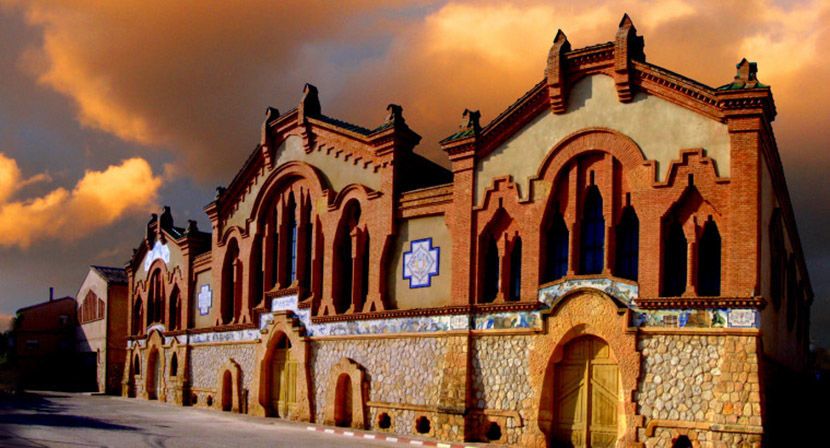
Audio 1. The beginning of the tour

Welcome to the El Pinell de Brai’s Wine Cathedral.
Next in this audioguide we are going to explain the rules all visitors are expected to follow.
- The first three audioguide stops will take place in the cathedral’s main façade. To continue the tour you will have to enter the building and follow the arrows marked on the ground. You must follow the path indicated.
- Please, respect and do not touch the tools and old machinery that you will find along the tour.
- Silence is requested throughout the tour, especially in the bouquet tunnel and inside the audiovisual room.
Audio 2. The Wine Cathedrals
Modernism in Catalonia was a political and cultural movement aimed at modernizing Catalan society and placing it within the European socio-economic context. Among others, it stood out mainly due to the splendid works of architecture, some of which were classified as World Heritage by UNESCO, such as the Guell Park, the Sagrada Familia Cathedral and the Batlló House...).
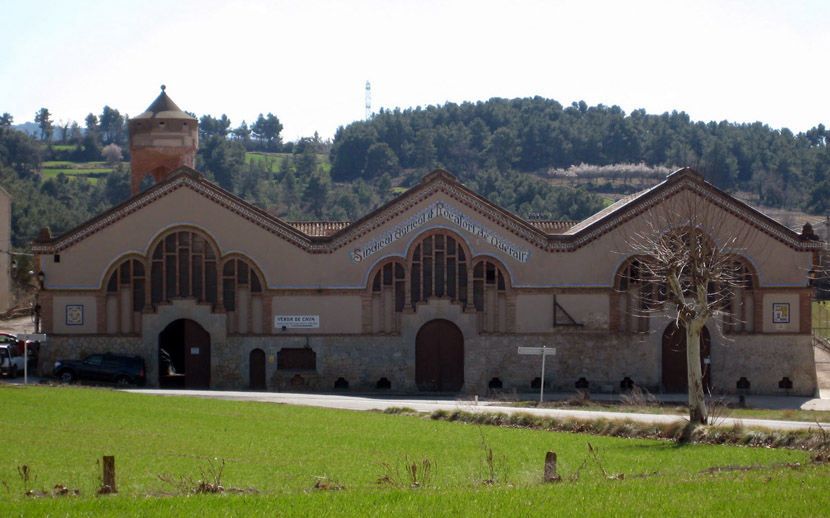
The Catalonia Commonwealth was the driving force behind the cooperative movement, which laid the foundation for the food industry in the early twentieth century. Different farmers joined efforts in order to increase production, share costs and reach new markets. These groups created an innovative trend resulting in an unknown synergy at that time, thanks to the union between the industry which sought functionality, optimization and result, and Modernist style architecture, which identified itself with design and elegancy.
Proof of this are the Wine Cathedrals, Wineries built in Modernist style between 1910 and 1920, mostly in the wine-growing regions in southern Catalonia, and particularly in the Montsant, Conca de Barbera, Alt Penedès and Terra Alta. Its name comes from Àngel Guimerà, a Catalan poet and playwright, who being impressed by the aesthetics and scale of the buildings, called them Wine Cathedrals in 1921.
Audio 3. The building and the facade
The El Pinell de Brai’s Wine Cathedral, constructed between 1919 and 1922, was built by architect César Martinell disciple of Antoni Gaudí. The building you can see with the audioguide has 4 naves: the main room is used to store wine, in the back is the second nave, the winemaking, and on a higher level, there is a grape-receiving area and water tank. The third room, known as the Fornal, was used as a wine aging room, and lastly, a two story nave intended for the oil mill.
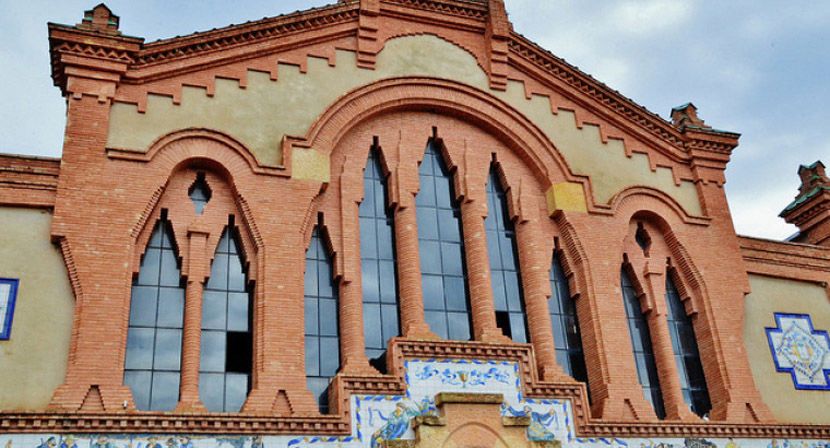
The El Pinell de Brai’s winery and olive mill are without a doubt one of the Catalan agrarian architecture’s jewels from the early twentieth century.
The building is noteworthy for its special design and beauty as a whole, which has made it to be known as “the wine Cathedral par excellence”. The combination of brick, stone and glazed tile, give it an aesthetic effect not common in these types of buildings. The parabolic arches in the main room as well as the imposing façade announce the majesty of the building, which was declared a Site of National Interest by the Government of Catalonia in 2002.
The Cooperative founders, excited about the economic boom of that time, asked the architect to make their winery the most spectacular one ever built. Therefore, in 1921, César Martinell commissioned an important artist to paint the frieze that can be seen on the façade. It was painted by Xavier Nogués, an outstanding draftsman, printmaker, painter and potter of the time. It is 42 meters in length and 80 centimeters high, which portrays the harvest, hunting, and the winemaking process with a satirical and expressive content on their characters’ faces.
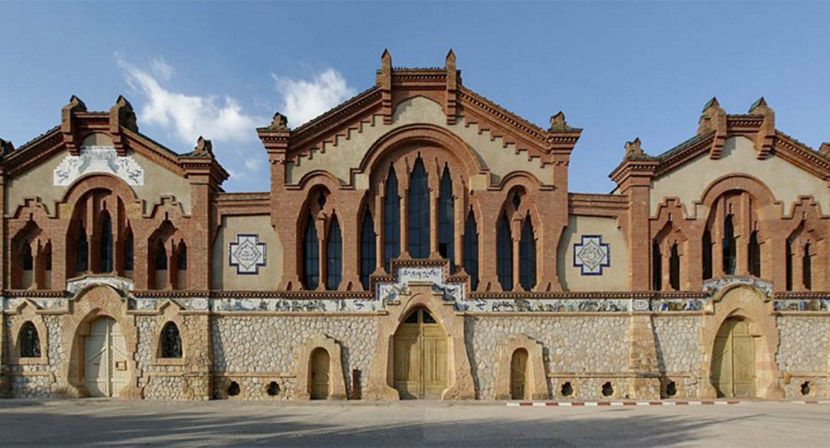
During the building construction’s final phase, the commonwealth dissolved, and so did the subsidies that were granted throughout Catalonia. In 1922 the building was completed with the board of directors in debt, with some pending payments. Subsequently the civil war broke out, and many documents were burnt reaching a payment agreement in the end. The difficult economic situation made the Board of Directors to order Caesar Martinell to stop the frieze work in order to reduce the debt, although it was already finished and waiting to be placed. Given that situation and not knowing anybody else, César Martinell decided to hide the frieze in the underground cellar, where it remained until 1950, date it was placed on the facade. This event allowed the frieze to stay intact during the Civil War (1936-1939), although part of the building’s nave and façade were damaged.
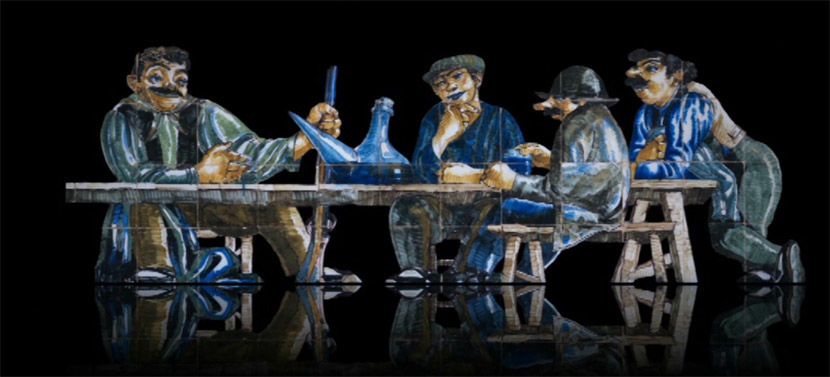
Another element that was removed in the construction due to economic reasons was the water tank, which would have been situated in the winemaking production nave. It was designed to be like a bell tower, something that would have emphasized its basilica shape.
Now let´s go into the building to discover the inside with the audioguide. Follow the arrows which indicate the correct way to enjoy the visit.
Audio 4. The Main Nave and the Museum
We are standing at the main Nave with the audioguide, used for the storage of wine. It is a large open space, divided only by two series of parabolic arches which support the roof. It holds 46 cement tanks of 30,000 liters of capacity and 25 underground tanks of 44,000 liters each. The Nave has a total capacity of over 2.5 million liters of wine, although it was never used entirely.
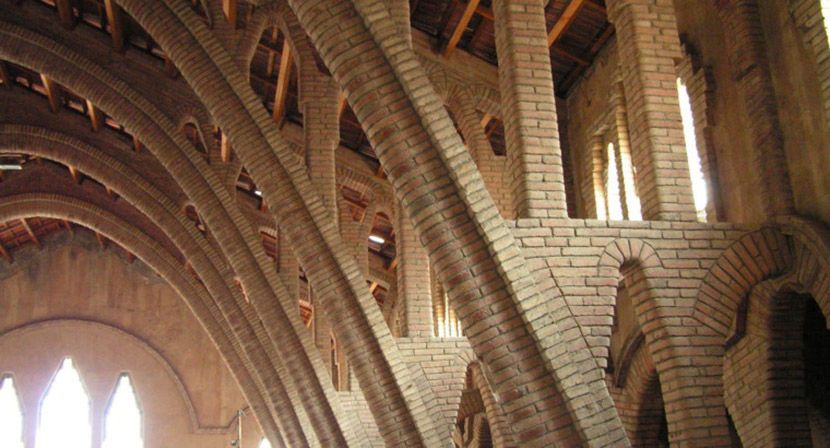
All this production was destined for European markets, mainly the French. This first hallway on the tour has been intended to house the restored machinery that was found in this building. On each machine it can be read what it is about.
Audio 5. The bouquet tunnel
Wine is a drink that is made for the enjoyment of the senses. Consequently, all the operations that are performed with it, from cellar technology to advertising campaigns to increase sales, affect the sensory aspect. Out of the five senses, smell is probably the one that contributes the most to the enjoyment of wine, so a great effort has been devoted to the learning process. For this reason we have prepared a game to learn more about the aromas associated with wine.
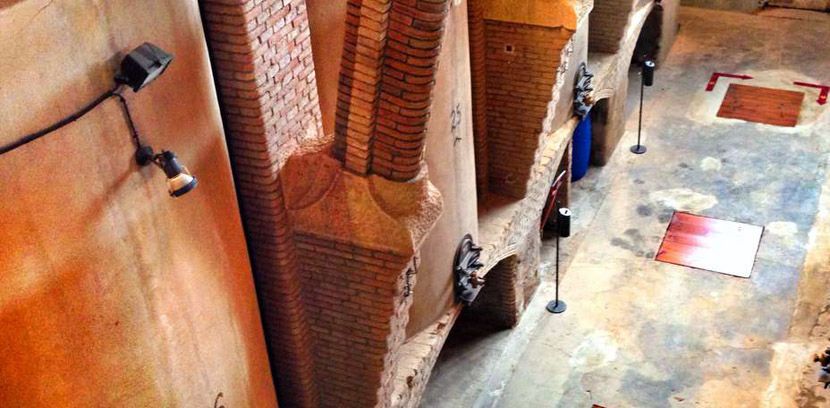
In this hallway there is a bouquet tunnel. To your right and left, there are some metal cups with a lid. Open the lid, smell the aroma that is inside, and try to figure out what it is. A few steps ahead, you will find written on the cement tank’s door the aromas’ name that you have just smelled. Remember that we have prepared aromas related to wine, so therefore, you will discover aging aromas and wine flaws. Good luck!! Please follow the way marked with arrows, maintain silence, and respect other visitors. After doing that, you can press the play button of the audioguide to continue the visit.
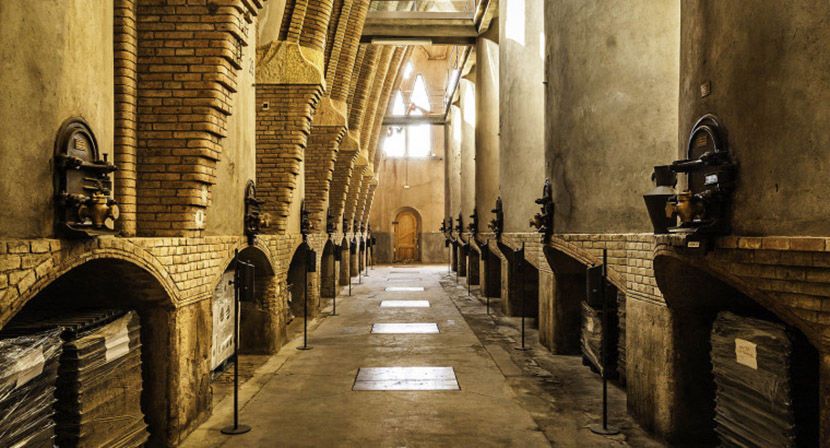
Audio 6. Today’s wine production
Unlike yesteryears, when farmers lined up in endless lines to unload their grape harvest, filling practically almost all tanks that we have seen today, today no more than five partners bring their grapes for winemaking. Our intention is to recover the essence of what the building was when it was built and give back its honor and dignity. With an increase in production by the members and a special dedication in pursuing quality, we want to obtain a wine that gives meaning to the majesty of these facilities.
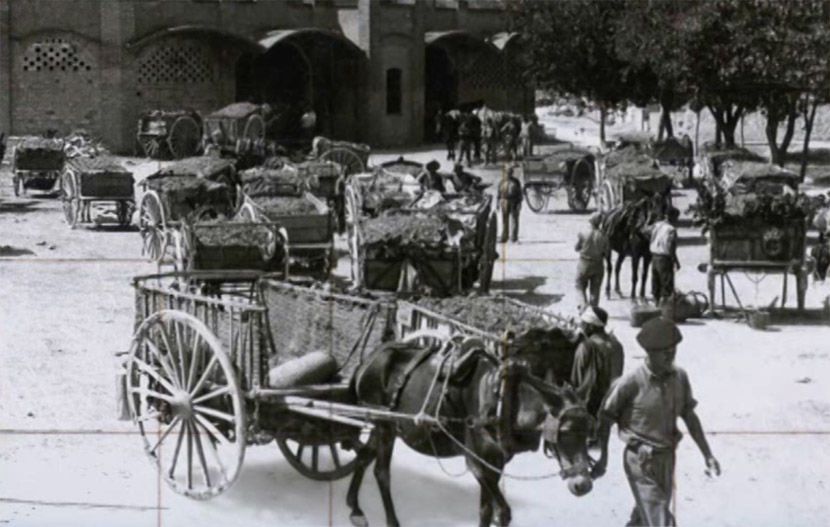
Because local production is not enough, grapes are also obtained from farms in neighboring towns such as Gandesa and Corbera d'Ebre. Most vines are old and planted in vertical trellising. The main red grape varieties are Grenache and Carignan. The most significant fact is in the white variety, which is the white Grenache, since 35% of the world production is in the Terra Alta Designation of Origin.
The varieties described have been cultivated in the area for hundreds of years, fitting perfectly into the local climate and the terrain. Our farms obtained fruit from really old vines, and this can be seen in the final product, obtaining great wines with a Mediterranean character.
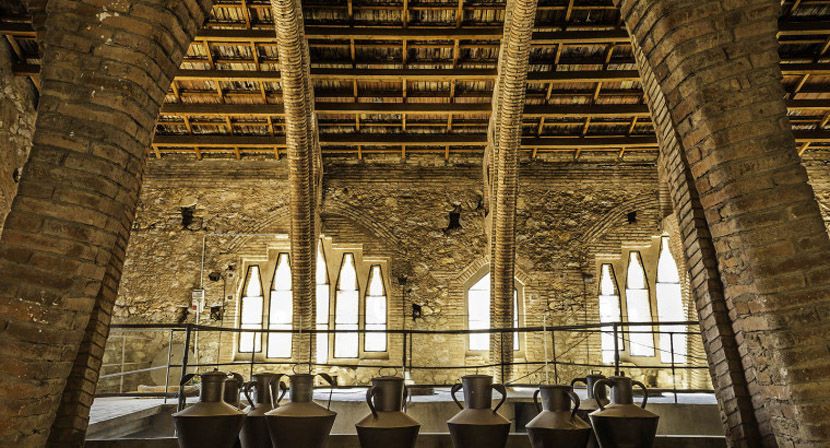
Looking up on the wall that connects this production room with the main tank room, you will be able to see clearly the strong influence of the "Gaudi" modernism represented in the hanging stairs, architectural watermark from the master builder.
Audio 7. Cèsar Martinell
Cèsar Martinell i Brunet was born in Valls in 1888 and died in Barcelona in 1973. In 1916, he obtained a degree in architecture and throughout his professional life; he built forty wine cooperatives, most of them in the southern regions of Catalonia. Besides being a great architect halfway between Modernism and Noucentisme, he was also a multifaceted character, standing out as a researcher, communicator and art historian.
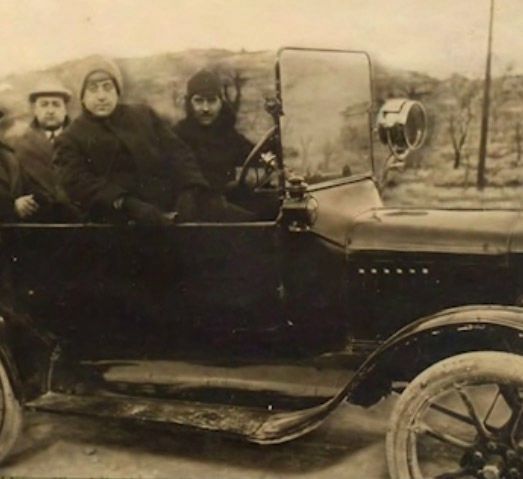
Martinell represents an intellectual transmission bridge between the second generation of the Catalan Renaixença masters (Antoni Gaudí, Lluís Domènech i Montaner, Josep Puig...) and the baby boomers. His agrarian architecture received the direct influence of Gaudí with whom he collaborated in the Holy Family Cathedral, as for spatial solutions, and the influence of Domènech regarding the forms and materials. Whereas his public and domestic architecture was infused especially with Noucentisme values (classicism and simplicity of lines), and the consecutive styles from that time: rationalism, monumentality, purity, etc.
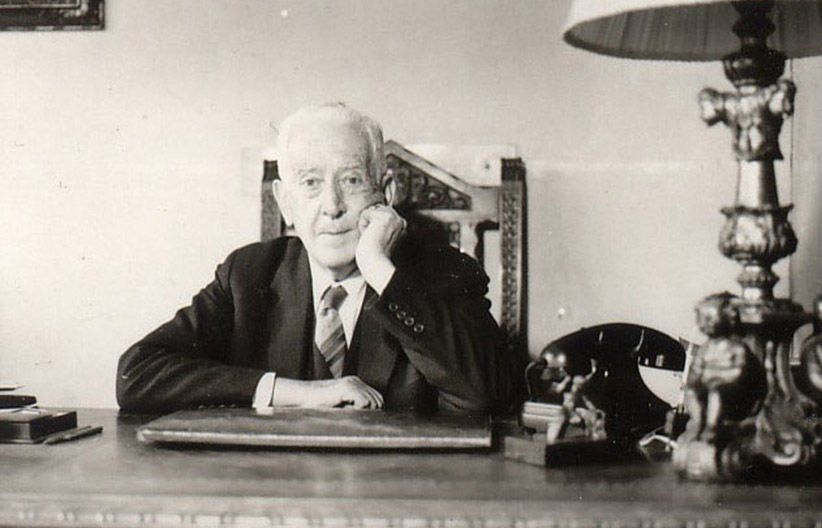
Audio 8. Interior design and functionality
Legacy from the style of his master Gaudi, Cèsar Martinell created the molded brick arches. Those we can see with the audioguide in the El Pinell de Brai are considered the largest in the world made with that technique. With a height of 19 meters from the ground floor to the highest point, the arches offer a spectacular image from the building interior which seeks an undeniable parallelism with cathedrals of worship. A beautiful building but at the same time relatively inexpensive, arches offered the author the opportunity to know the exact number of bricks needed in the construction and the exact cost of the work, which amounted to 1,075,000 pesetas.
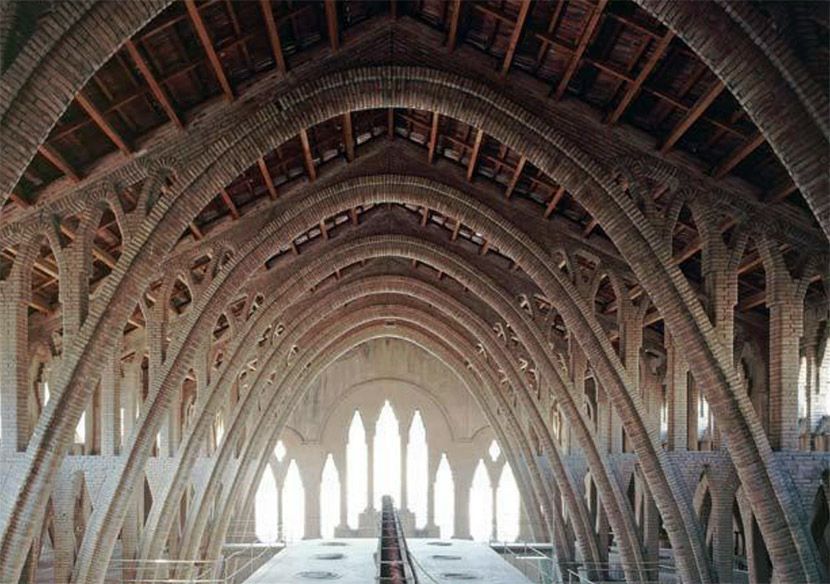
As a great specialist in agricultural buildings, Martinell not only designed buildings with great architectural beauty, but also incorporated new techniques in order to facilitate the work. Thus, he organized the space for the production process, was concerned about the shape and location of the deposits, the insulation systems and fluid flow, the situation of the windows for ventilation, and the fermentation conditions... all in order to improve the final result.
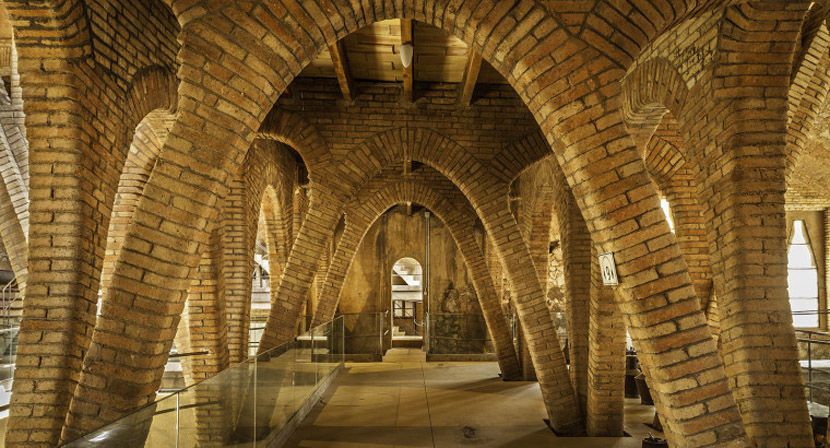
Audio 9. The first frieze
At this point of the audioguide you will be able to appreciate more objects found in the building, among them stand out an authentic frieze by Xavier Nogués. It was a proof that the artist made and which later he would replace by the one that is currently in the facade.
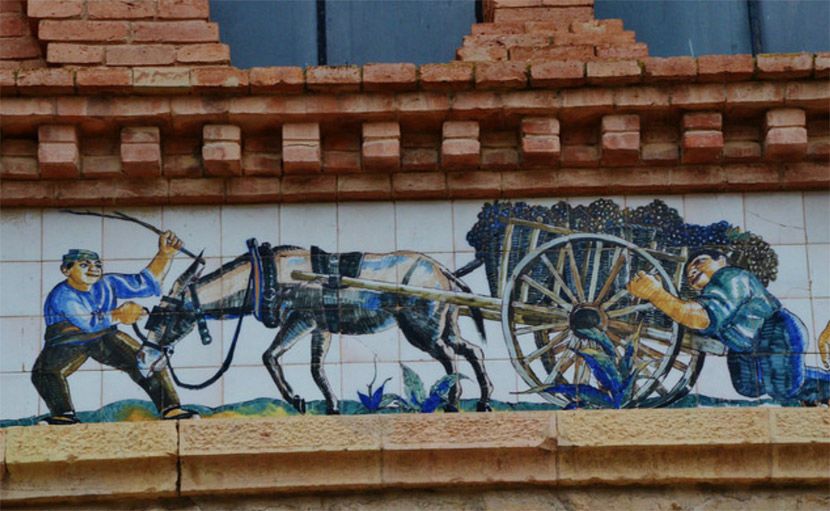
Audio 10. Production by gravity
Concerning the process of winemaking, Martinell used the movement technique of gravity, a technique that the architect conceived in the early twentieth century in the El Pinell de Brai. While existing wineries spent huge sums of money in order to convert their wineries, so that the natural movement of the grapes and the liquids used gravity, Martinell designed a circuit that smartly used this objective through the following phases: Once the grapes were weighed on the scale located behind the building at street level, they were thrown down a chute, where by using mechanical gear, the grapes were picked up by metal containers and were lifted up to the top of the building, where a grape crusher was situated. If you look at the back of the building while listening to the audioguide you will still be able to see the original crusher.
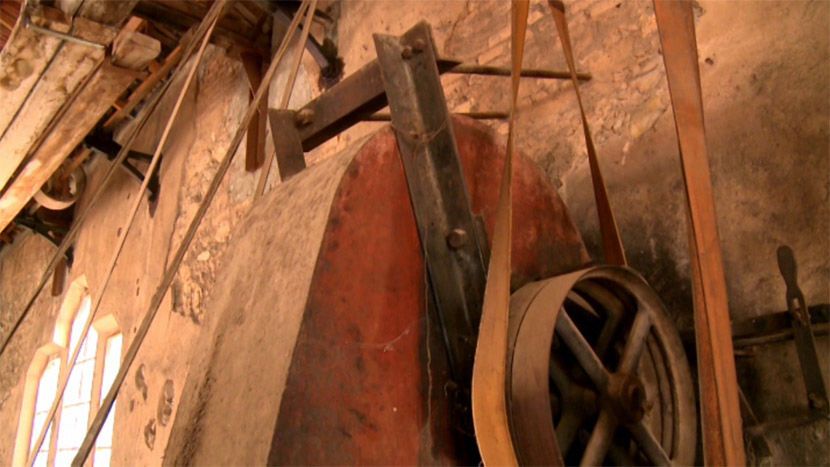
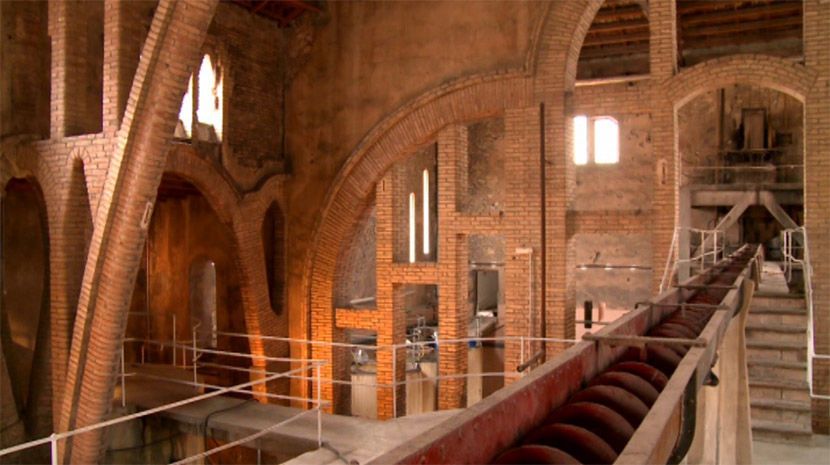
In the crusher the olive flower and the grape were separated, while the olive flower went down a long a ramp over to the production room, the grape came through an endless screw, which distributed the grape to all cement deposits. As you can see, the endless screw is the threaded metal tube that runs through the nave where we are standing. Once the fermentation was over, the finished wine was transported by gravity and stored in the underground tanks until it was brought to the market.
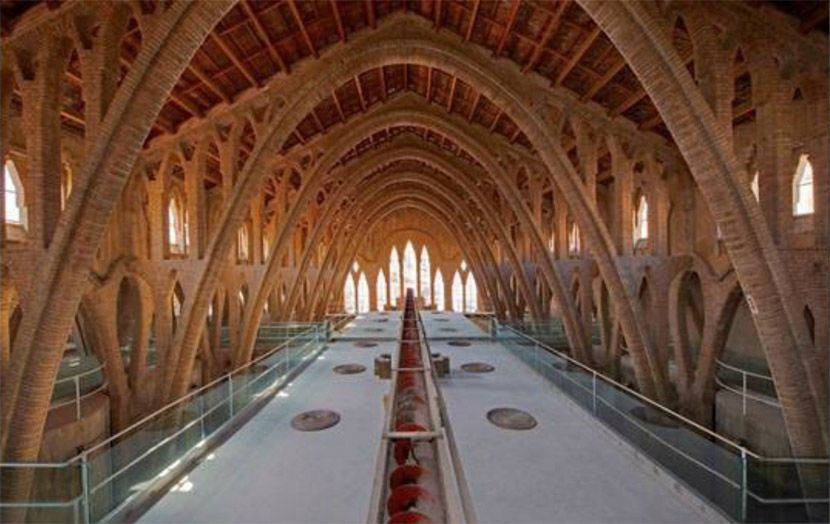
This system sought to minimally affect the grape, following a natural circuit, without any pressure caused by the pumps. This detail is much appreciated today, since it is intended that the grape arrives at the tank in the best possible condition, and be able to extract the best organoleptic performance. Today the best wineries in the world implement this technique.
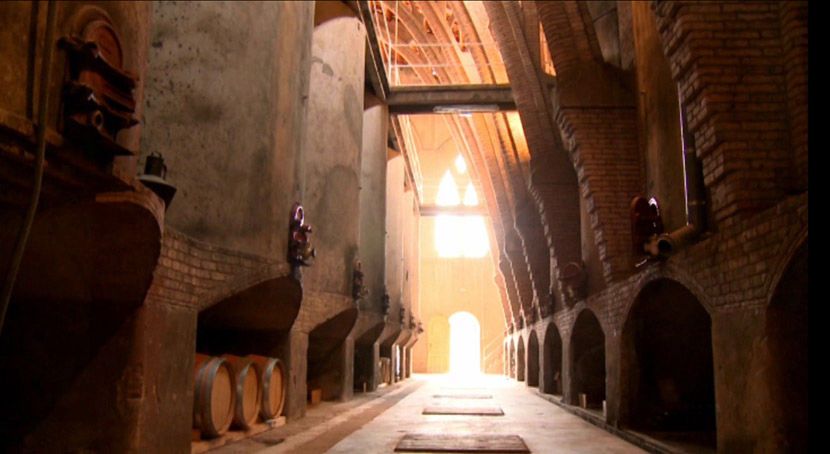
Due to the fact that El Pinell’s Wine Cathedral business was decreasing, investments to reconvert the old machinery with new and more advanced production systems never came. This involuntary fact was compelled by the economic perspectives at that time. Thanks to that, the original wine production equipment and oil mill still exist today.
All mechanisms, machinery, and systems that can be observed here are the same as Cesar Martinell projected, and still work, even though they are not used today. They are really another of this architectural work.
Audio 11. The audiovisual room
The next room we will visit with the audioguide is called the Fornal, where the wine aging took place in the past. Today, it is used as an audiovisual room. Two twenty-minute-videos are going to be shown, and after that, we will carry on with the visit. The time remaining to start the next session can be seen on the screen. It is not allowed to enter the audiovisual room until 5 minutes before the movie starts. Once inside, please keep silent.
The videos are in Spanish, but they can also be heard in your own language with the help of this audio guide. In order to do so, please follow carefully these simple instructions:
- Enter the room and take a seat.
- To connect the audioguide to the video, press number 0 and the play button on your audio guide just at the time the countdown displayed on the screen reaches zero. Remember: It is very important that when the countdown on the display reaches zero, you must press both buttons at the same time. Thus the audioguide will synchronize your language with the screen images.
- Once the audio is connected to the video, do not to touch the audioguide again until both videos have finished and you have left the room. Before entering the room, press the number zero and the play button a few times in order to practice. In order to listen to these instructions again press the number 11 and the play button.
Audio 12. The Fornal room
This is the Fornal room, used for the aging of wine. It was built in the typical Catalan vault technique which has a great lightness and strength. The materials used are ceramic and of small dimension, placed side by side and interlocked until the construction of the vault ends. As for the vault’s strength and dimension, different types of materials are used such as: normal bricks, brick with holes, tiles...
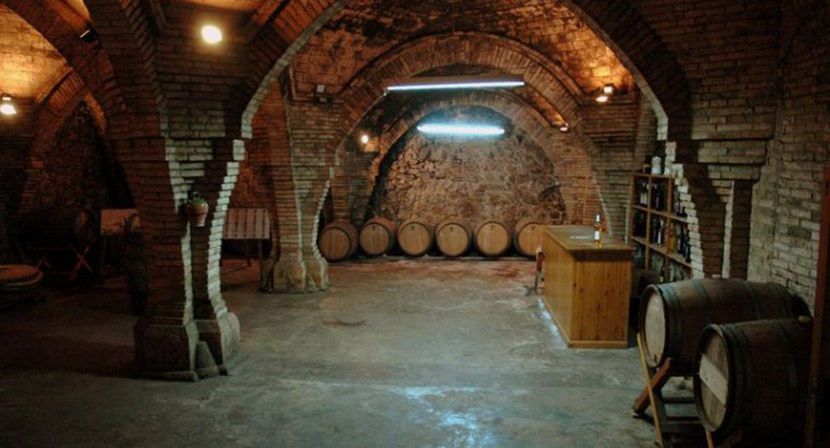
We're underground; above these vaults there is an air chamber that isolates the interior temperature from the outside. At first, the winery’s main nave wanted to be built with a Catalan vault, but due to the insistence of all partners that wanted to make the El Pinell de Brai`s winery more spectacular than the neighboring winery which has a Gandesa modernist stile, they decided to substitute the Catalan vault for molded brick arches.
Audio 13. The oil mill
The oil mill the audioguide is showing us operated for the first time in 1919. It consisted of two rooms, the mill room, where we are standing now, and the olives room, located on the top floor. The olives arrived in the upper room, where they were separated between those collected from the soil and those harvested from the tree. Once there, they were passed to three stone cones by gravity, where they were crushed after seven or eight laps. The paste wend down to the "italians", consisting of two cylindrical stones and hot water circuit, where after approximately one hour the pit broke, leaving the paste obtained ready to move to the "cofins" a shaped-wheel-basket.
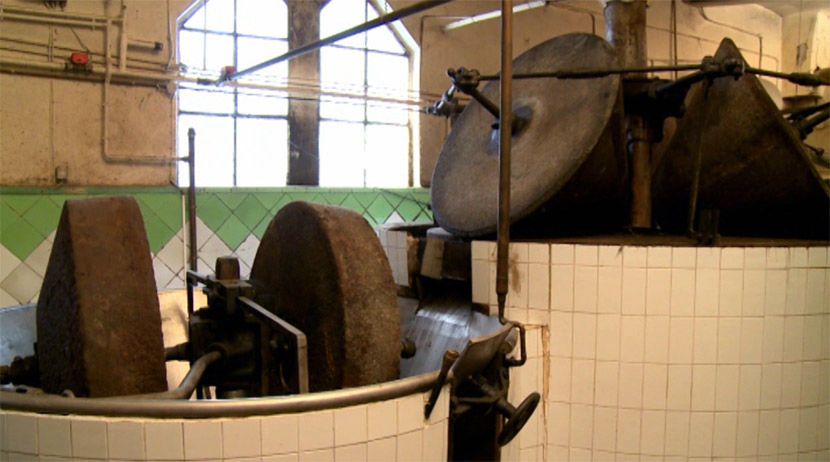
The “coffins” were placed on top of each other inside the minecart, which moved along the rails up to the press. After two hours and when the pressure reached over 400 atmospheres, all the juice was extracted separated from water by decantation.
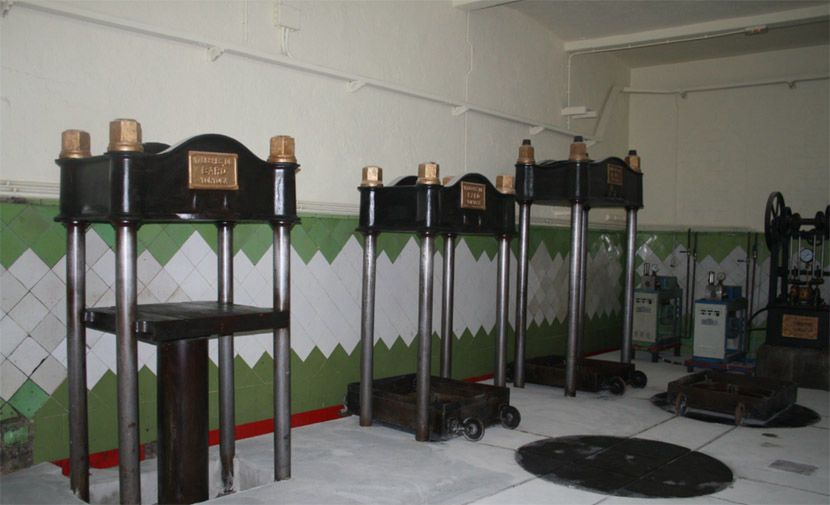
The resulting oil was poured into eight underground tanks for storage. Today three deposits still remain intact which can be seen in the shop.
Today, to produce oil, only olives collected by partners are used and transported to a modern mill that with the today’s technology and hygiene and by keeping the essence of the past (giving priority to product quality and performing a cold oil extraction), obtain one of the best Terres de l'Ebre’s oils.
Audio 14. Wine testing and oils. The shop

We have reached the end of the visit with the audioguide. Now you have the possibility to purchase our products in the shop, as well as tasting them. To do this, proceed to the reception booth, where personnel will gladly accompany you to the olives old room, currently fitted as a wine tasting room and restaurant.
Audio 15. Modernista white wine

Young white wine from Macabeo varieties and white Grenache. Made from vines between 15 and 35 years old. Only the flower must is used. This young white wine is very easy to drink, and has the bonus of having an excellent quality-price. Once poured it has a yellow straw color with greenish reflections. It has a smell of white fruits and flowers. It is fresh and balanced in the mouth, with a long and absorbing finish. The right wine for appetizers, seafood rice and mild fish. Ideal for warm summer nights.
Audio 16. Modernista White Grenache wine

Young White Wine, 100% White Grenache. It is a white wine made from a selection of white Grenache from 80-year-old vines. This varietal wine from the Modernista family has a bright straw color. Its varietal aroma is elegant with ripe fruit and tropical hints. It is tasty, fruity, fresh, and meaty in the mouth, with pleasant step, which shows all the splendor of the old vineyard and the youth in its preparation. It is ideal for heavy dishes such as deli meats, rich cheeses, oily fish and some white meat.
Audio 17. Modernista red wine

Young red wine from the Grenache, Carignan and others varieties. It is a deep red color wine with violet edge. It shows an intense aroma of red fruits to the nose with a sweet concept. The mid-palate is intense, soft, leaving a ripe fruit flavors. A long and fruity finish.
Audio 18. Indià white wine

Young White Wine, 100% white Grenache. Made from vines between 35 and 65 years old. Only the flower must is used. It is a pale yellow color with golden reflections expressing the transparency reaching every sense. It is fruity, floral and very fragrant to the nose. With tropical fruit tones, mixed with hints of peaches, leaving room for the roses and jasmine persistence. It is balanced, rich, while staying fresh in the mouth with a very complex finish. It is a persistent, very varietal and a marked personality of our Denomination of Origin wine.
Audio 19. Indià Red Oak wine

Red wine varieties 85% Grenache and 15% Carignan with semi-aged for 4 months in second year barrels. The Indià red wine is a young short aging wine. Explosion of cherries and red fruits. Attractive touches that invite you to continue drinking. It is a friendly wine that accompanies both meat and pastas. Ideal as a starter and also for having a social gatherings.
Audio 20. Gamberro White Gerniche wine

White Wine Grenache 100% from vines that are over 80 years old. Fermentation and ageing for 8 months in new French oak barrels. Stored for 12 months in a bottle. It requires about 30 minutes to sit before consumption. It is a white wine made from the best selection of 80 and 90 year-old-white-Grenache. Once the grapes are selected at the vineyard, they are transported in small 12-kilo-boxes in order not to be damaged. At the winery, the grapes are selected by hand to ensure that the grapes reach the press as a whole. The pressure force applied is very subtle, in such a way that the green grains stay out of the process. Part of the fermentation and aging is made in French new oak barrels and for 8 months the "batonage" technique is used. It is an extremely well-structured wine with strength and character. Oxidative nuances species and ripe fruit in the mouth, make a long and enveloping sipping wine, with retro-olfactory persistent and wide amplitude.
Audio 21. Gamberro de Guarda Red wine

Red wine with varieties 60% Syrah, 30% Carignan and 10% cabernet sauvignon. A 16- month-aging in new French oak barrels from Allier and 12 months in bottle. Live cherry violet-colored wine. Expressive to the nose, perfumed, with volume and good definition that includes animal notes, some floral memory and a toast background with black licorice. A character wine, wide in the mouth, fleshy with spiced and ripe red fruit nuances which present a good attack, good acidity, with excellent long development. With structure and presence. Long evolution in bottle.
Audio 22. Sweet Gamberrillo wine

It is our sweet wine. Fortified wine made with 100% very old Carignan and very limited production (only 200 liters). With red fruits, dried figs and grapes. Hints of tomato and wood. It fills the mouth with syrup in a sweet but balanced drink. Accompany chocolate and dry nuts desserts as well as vanilla and sweets.
Audio 23. Modernista Extra Virgin Oil
The audioguide suggests you try this superior category extra virgin olive oil from the Wine Cathedral. Made primarily with the empeltre, Arbequina, morruda and farga varieties, obtained directly from olives and only by mechanical cold extraction method. Our special selection gives an intense green fruity aroma with notes of freshly cut grass and tomato plant. Oil of great body, with a smooth burn and bitterness indicative of a great share of antioxidants (polyphenols). Its high content of oleic acid makes it more beneficial and an essential component of the Mediterranean diet, which is much appreciated nowadays. We also have ancient olive groves form farga variety which produce another limited oil production.
Bluehertz Audio guides has developed for the Wine Cathedral an audio guide service avaliable in Spanish, Catalan, English, French and Rusian languages.
Wine Cathedral: Calle Pilonet 8, 43594 - El Pinell de Brai (Tarragona) Catedral del Vino
- Tel.: +34 977 426 234 - www.catedraldelvi.com - bodega@catedraldelvi.com -
Back to index